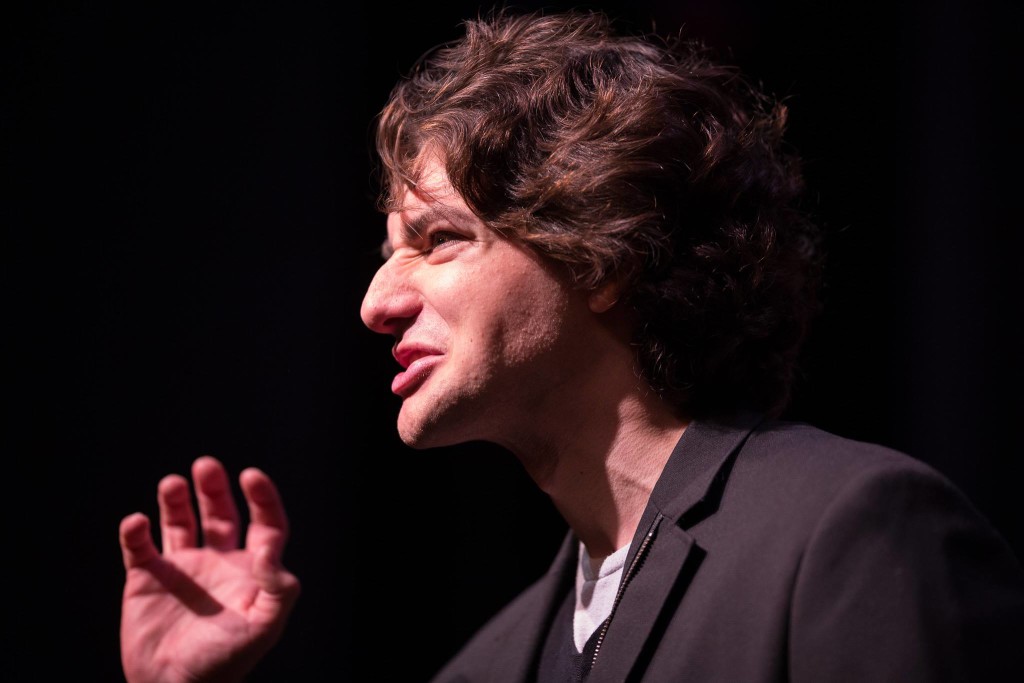
Everyone knows the story of Hamlet, whether it be from The Lion King, a TV show, or a forced reading of Shakespeare’s most famous tragedy in a high school English class. The tale has become trite to the public, one of a whiny kid who runs away from his responsibilities until it is too late, and everyone dies. It’s an extreme challenge to take a story beaten to death by countless film adaptations, YouTube parodies, and purified cartoon reboots and once again restore it into a classic tale of woe that translates into the universality of the human soul. To undertake such a challenge takes talent; talent which the Stanford Department of Theater and Performance Studies’ cast of Hamlet definitely does not lack.
This famed tale of the Danish Prince is reimagined with modern costuming, militaristic guards holding guns and courtiers donning suits—a decision that seems disjointed with the rest of the production, which holds the original Shakespearean dialect, a beautifully constructed castle-like set, and minimal props that look straight out of 16th century Denmark.
Andre Amarotico’s performance of the titular character’s debated descent into madness is terrifying, characterized by his clenched, shaky fists, bulging eyes, and choked, forceful movements of despair. The intensity of his delivery forces the audience to hang on to his every word, charged with hoarse desperation and crippling melancholy. Amarotico is Hamlet in every connotation of the name, balancing his true, broken self with a hilariously erratic sense of feigned madness that sends the audience into laughter, even after he mesmerizes them with his internal battle.

Director Rob Melrose interprets Hamlet and Ophelia (Jessica Waldman)’s relationship as incredibly sexualized, angst-ridden and borderline abusive. Waldman and Amarotico perform scenes with a subdued intensity, breaking into animalistic rage and unbridled helplessness when they interact alone. Waldman’s portrayal of Ophelia is heart-wrenching, innocence destroyed by the wrath of the world—her madness is beautiful in contrast with the quiet restraint she exercises beforehand, a delicate flurry of rage that culminates in a sadly sweet blank stare and joyless meandering off stage and into the tragic world that has destroyed her.

Claudius (Louis McWilliams) is powerful and imposing, a booming voice and sly smile of superiority elevating his status as the new ruler of Denmark into the sphere of reality, and by his side Gertrude (Kiki Bagger) remains as regal and elegant as a queen should be, sweeping the stage in long, graceful strides and her chin poised upward. This picturesque vision of monarchical power deteriorates as the play progresses, and McWilliams and Bagger execute this decline perfectly; through his sinister subplots, we see McWilliams shatter the image of the stoic king by allowing his neurosis and paranoia to break through, using quick speech and forceful motions to convey his desperation to keep his image, title, crown, and queen. Bagger’s inner turmoil slowly forces its way into her exterior, her breaking point coming in the form of a pseudo-rape staging of the famed closet scene between her and her son Hamlet. Her voice is shrill and broken with terror, her body flung onto her bed in disarray, cowering and unable to process the deterioration of her life around her—the opposite of a queen.
Comic relief comes most notably in the form of the pompous Polonius (Tynan Challenor). With a puffed out chest, fingers perpetually tugging at his belt loops, and an oblivious delivery of ironic lines with an air of false and self-serving superiority, Challenor’s performance of the ill-fated and somewhat dimwitted statesman shows a beautiful understanding of the character, despite the indefinite quality of Shakespearean text.

A common motif throughout the production is the “play within a play” theme, inherently acknowledging its own theatricality. From Hamlet jumping off of the stage and interacting with the audience halfway through his “O what a rogue and peasant slave am I” monologue to Claudius addressing the audience as if they were the people of Denmark he needed to assure all was well, this theme is quite appropriate for a production by the Stanford TAPS Department—but it also allows us to see the falsifiability, shallowness, and malleability of such a corruptible world.
To study the humanities is to study the human experience. It’s incredibly easy for one to fall flat in this regard, focusing more on the literal rather than the emotion hidden between the lines of a text. This attentiveness to emotion is the true gift of the cast of Hamlet. Without an inherent understanding of the intricacies of how humans function, interact, convey, represent—any piece of art can become as shallow as the court of Denmark.
***
Photos courtesy of Frank Chen.

Sidney Waldman
March 9, 2015 at 8:00 am (2 years ago)enjoyed, thank you
Sidney Waldman
March 9, 2015 at 8:00 pm (2 years ago)Jessica, You look great you are great, and to boot you are a great actress. But then you are the product of good hard working grand parents,topping it of with A family that is great. ps i am getting smaller but you look a lot better keepit up you will never be heavy